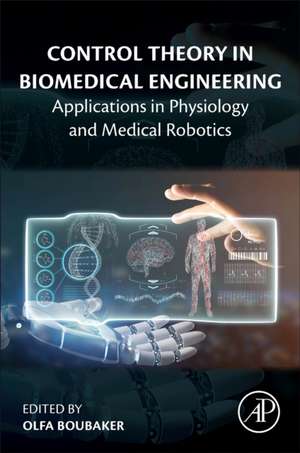Control Theory in Biomedical Engineering: Applications in Physiology and Medical Robotics
Editat de Olfa Boubakeren Limba Engleză Paperback – 29 iun 2020
Control theory profoundly impacts the everyday lives of a large part of the human population including the disabled and the elderly who use assistive and rehabilitation robots for improving the quality of their lives and increasing their independence.
- Gives an overview of state-of-the-art control theory in physiology, emphasizing the importance of this theory in the medical field through concrete examples, e.g., endocrine, immune, and neurological systems
- Takes a comprehensive look at advances in medical robotics and rehabilitation devices and presents case studies focusing on their feedback control
- Presents the significance of control theory in the pervasiveness of medical robots in surgery, exploration, diagnosis, therapy, and rehabilitation
Preț: 597.24 lei
Preț vechi: 952.34 lei
-37% Nou
Puncte Express: 896
Preț estimativ în valută:
114.32€ • 124.22$ • 96.09£
114.32€ • 124.22$ • 96.09£
Carte tipărită la comandă
Livrare economică 14-28 aprilie
Preluare comenzi: 021 569.72.76
Specificații
ISBN-13: 9780128213506
ISBN-10: 0128213507
Pagini: 396
Ilustrații: Approx. 300 illustrations
Dimensiuni: 152 x 229 mm
Greutate: 0.53 kg
Editura: ELSEVIER SCIENCE
ISBN-10: 0128213507
Pagini: 396
Ilustrații: Approx. 300 illustrations
Dimensiuni: 152 x 229 mm
Greutate: 0.53 kg
Editura: ELSEVIER SCIENCE
Public țintă
Researchers and graduate students in both control engineering and biomedical engineering fields. Medical students and practitioners who want to enhance their understanding of physiological processes and medical robotics. Professionals in medical industries including those of industry of medical robotics, of artificial devices, of artificial organs and rehabilitation devicesCuprins
Part I. Applications in Physiology
1. Modeling and Control in Physiology
2. Mathematical Modeling of Cholesterol Homeostasis
3. Adaptive Control of Artificial Pancreas Systems for Treatment of Type 1 Diabetes
4. Modeling and Optimal Control of Cancer-immune System
5. Genetic Fuzzy Logic based System for Arrhythmia Classification
6. Modelling Simple and Complex Handwriting based on EMG Signals
Part II. Applications in Medical Robotics
7. Medical Robotics
8. Wearable Mechatronic Devices for Upper Limb Amputees
9. Exoskeletons in Upper limb Rehabilitation: A Review to Find key Challenges to Improve Functionality
10. A Double Pendulum Model for Human Walking Control on the Treadmill and Stride-to-stride Fluctuations: Control of Step Length, Time, Velocity and Position on the Treadmill
11. Continuum NasoXplorer Manipulator with Shape Memory Actuators for Transnasal Exploration
12. Tunable Stiffness using Negative Poisson’s Ratio Towards Load-bearing Continuum Tubular Mechanisms in Medical Robotics
1. Modeling and Control in Physiology
2. Mathematical Modeling of Cholesterol Homeostasis
3. Adaptive Control of Artificial Pancreas Systems for Treatment of Type 1 Diabetes
4. Modeling and Optimal Control of Cancer-immune System
5. Genetic Fuzzy Logic based System for Arrhythmia Classification
6. Modelling Simple and Complex Handwriting based on EMG Signals
Part II. Applications in Medical Robotics
7. Medical Robotics
8. Wearable Mechatronic Devices for Upper Limb Amputees
9. Exoskeletons in Upper limb Rehabilitation: A Review to Find key Challenges to Improve Functionality
10. A Double Pendulum Model for Human Walking Control on the Treadmill and Stride-to-stride Fluctuations: Control of Step Length, Time, Velocity and Position on the Treadmill
11. Continuum NasoXplorer Manipulator with Shape Memory Actuators for Transnasal Exploration
12. Tunable Stiffness using Negative Poisson’s Ratio Towards Load-bearing Continuum Tubular Mechanisms in Medical Robotics
